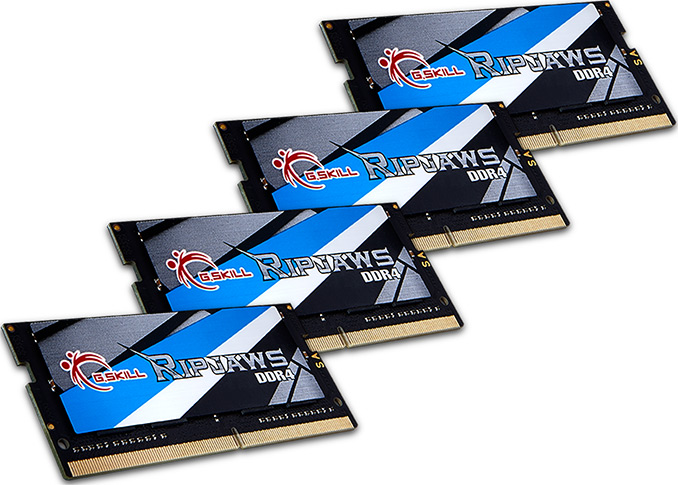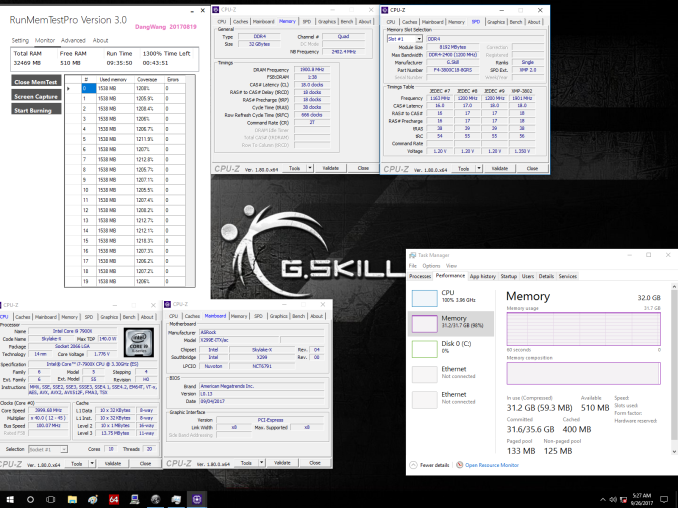G.Skill Announces DDR4 SO-DIMM Kits up to DDR4-3800: Ripjaws for SFF
by Anton Shilov on October 23, 2017 2:00 PM EST
G.Skill has announced its new family of Ripjaws DDR4 SO-DIMM kits designed specifically for Intel’s Core X processors. The current number of consumer motherboards supporting SO-DIMMs is limited: only the ASRock X299E-ITX/ac motherboard is at retail, although there could be potential to see some high-performance notebooks also make use of the high-performance memory. The modules being launched operate from DDR4-3200 to DDR4-3800 and are currently are the fastest DDR SO-DIMMs in the industry.
Intel’s latest processors for high-end desktops feature the company’s new-generation memory controllers that can handle very high DDR4 data transfer rates. Full-size PCs can take advantage of this capability because there is a wide choice of DDR4 modules, and we have seen modules rated for DDR-4000 and higher hit the market. By contrast, motherboards such as the ASRock X299E-ITX/ac use SO-DIMMs, of which the choice is limited due to the low number of SO-DIMM capable motherboards and systems. At present, the fastest SO-DIMMs are rated for DDR4-3200 (the Ripjaws DDR4-3200 16 GB kit), so in a bid to offer owners better memory performance, G.Skill this week introduced a new family of its Ripjaws DDR4 SO-DIMM kits.
The new high-speed 8 GB and 16 GB memory modules are based on Samsung’s B-die DRAM ICs used for most enthusiast-class memory hitting very high speeds. G.Skill will offer four different SO-DIMM kits, being advertised as optimized for the ASRock X299E-ITX/ac and Intel’s Skylake-X processors: three 32 GB kits rated to operate in DDR4-3200/CL16, DDR4-3600/CL16 and DDR4-3800/CL18 modes as well as one 64 GB DDR4-3200/CL16 kit. All new modules feature XMP 2.0 profiles and require 1.35 V.
| G.Skill's Ripjaws DDR4 SO-DIMM Kits for SFF PCs | ||||||
| Speed | Sub-Timings | Voltage | Kit Config. |
Kit Capacity |
||
| DDR4-3200 | CL16 16-16-36 | 1.35 V | 4×8 GB | 32 GB | ||
| 4×16 GB | 64 GB | |||||
| DDR4-3600 | 4×8 GB | 32 GB | ||||
| DDR4-3800 | CL18 18-18-38 | 4×8 GB | ||||
While the new SO-DIMMs are compatible with the latest laptops that use Intel’s desktop Coffee Lake CPUs (from Clevo, Eurocom and others), it is unknown whether they can work and remain stable at full speed in them. Laptops typically a different memory sub-system topology than desktops and therefore may require some additional SPD tuning. As a result, G.Skill has positioned the new Ripjaws DDR4 kits only for “SFF platforms” rather than DTR laptops.
G.Skill says that its new quad-channel Ripjaws DDR4 SO-DIMM kits will be available from its partners in early December. The company does not disclose estimated MSRPs of the new kits, but since these are unique memory modules built for a unique platform, expect them to be priced accordingly. For example, G.Skill’s previous-generation Ripjaws DDR4-2800 32 GB SO-DIMM kit is priced between $348 and $390 in the U.S. Meanwhile, the aforementioned G-Skill’s dual-channel Ripjaws DDR4-3200 16 GB kit is priced at $250.
Related Reading
- ASRock’s X299E-ITX/ac Motherboard Now Available: Up to 18 Cores in Mini-ITX
- DRAM and Motherboard Makers Demonstrate Quad-Channel DDR4-4000+ Operation
- The Intel Skylake-X Review: Core i9 7900X, i7 7820X and i7 7800X Tested
- The Intel Core i9-7980XE and Core i9-7960X CPU Review Part 1: Workstation
- Transcend Introduces Extreme Temperature DDR4 SO-DIMMs
- Patriot to Release Viper DDR4-2400, DDR4-2800 SO-DIMMs for Laptops
Source: G.Skill











7 Comments
View All Comments
JoeyJoJo123 - Monday, October 23, 2017 - link
The DDR4-3600 at CL16 presumably has the least latency of the ones listed and looks to be pretty interesting.I'd imagine it'd be good for a small form factor gaming PC, perhaps with ASRock’s X299E-ITX/ac board, but really the only point of getting something like that would be because you need a Xeon's CPU thread count, but in a small package, with only as much as a single workstation GPU or a 10GiB NIC card. And if you're going the pro-work Xeon route, it's smarter to just mate it with ECC SO-DIMM.
I guess maybe it's good as an aftermarket memory upgrade kit for some of the 10lb+ desktop replacement SLI notebooks out there?
JoeyJoJo123 - Monday, October 23, 2017 - link
To elaborate further, if you explicitly wanted Mini-ITX PC gaming, you'd be better off with an 8700K overclocked near 5GHz (or whatever you can reach given thermal/noise restraints on relatively small Mini-ITX cases with restricted clearance for cooling options. Mini-ITX gaming PCs also have access to regular sized DIMM slots, too.JoeyJoJo123 - Monday, October 23, 2017 - link
Wow. Ignore all of the above.http://www.asrock.com/mb/Intel/X299E-ITXac/index.a...
According to the above, the X299E-ITX does NOT support ECC (despite traditionally HEDT platform supporting ECC if a Xeon CPU is in use). Therefore these memory kits ARE well mated to the overkill board recently mentioned here at AnandTech.
LeahFleming - Monday, October 23, 2017 - link
I resigned my office-job and now I am getting paid £64 hourly. How? I work over internet! My old work was making me miserable, so I was forced to try something different, two years after...I can say my life is changed-completely for the better!Check it out what i do... http://cutt.us/EnRTV
Lolimaster - Tuesday, October 24, 2017 - link
Why they keep advertising this for intel when it's Ryzen the cpu that benefits and even more Ryzen+Vega APU's on mobile with thse SO-DIMMCheapSushi - Tuesday, October 24, 2017 - link
It's time for SODIMMs to be the standard on Core & Ryzen boards, from mini-ITX, all the way to ATX. We seriously lose nothing coming down from full DIMMs. The board space savings would be significant (you could do so much more, like better position for power, SATA & U.2 ports or add an M.2 slot in the area). Since ECC is extremely artificially market segmented, we don't even end up using most of the extra pins on full DIMMs. We don't get ECC extra chips, we don't get Registered/Buffered ICs, Instead we get a dated design with wasted PCB, wasted motherboard space and zero benefit to most gamers & enthusiasts.DDR4 SODIMMs still have significantly more pins than even full DDR3 had. SODIMMs still have a density when double stacking.
I want Anandtech to do an article about this. Like really do research on the pros and cons, what's the issue, why not? Why isn't it the norm? Is it just one of those things where absolutely no one really bothers to question it because it's just always been that way? I think it's time for a change.
Full DIMMs without a doubt have their place on workstation and server boards or enthusiast boards that support ECC (thus need the extra pins), like Xeon-W and Threadripper potentially. But, we're wasting a lot for the vast majority of users.
There's plenty of SODIMM kits coming out now as shown! There's already a push for DDR5 and I feel like we still haven't really maxed out the potential of DDR4. Hell, the current JEDEC spec is at 3200MHz, is there a 3200MHz ECC kit out there? NOPE. Still so much missing.
CheapSushi - Tuesday, October 24, 2017 - link
Forgot to mention but it's nuts seeing so many weaker mini-ITX boards still using full slots after you see something like ASRock's X299E-ITX/ac with SODIMMs.